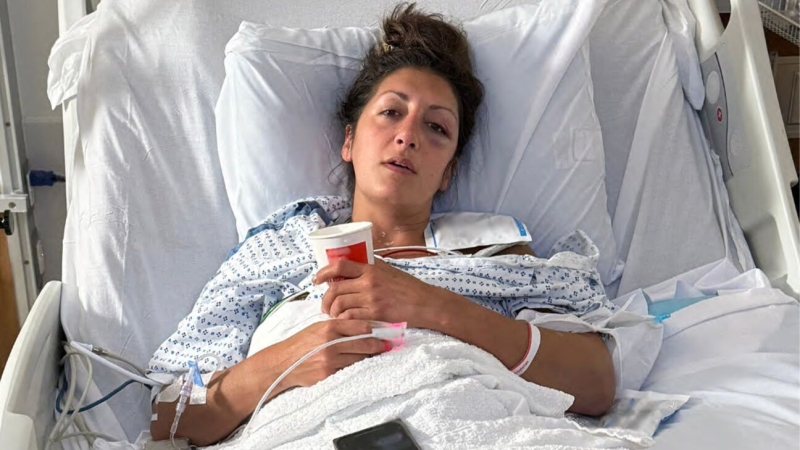
- Teacher Krista Figari is opening up about how she experienced a “wake-up” stroke at the age of 39.
- This includes sharing video clips of the event that were captured as it happened.
- Figari is sharing her story to help others recognize the symptoms of stroke and raise awareness.
- Early intervention of stroke can help save lives.
Krista Figari went to sleep on April 18, like any other night. However, around 4:45 a.m., her life changed.
“I remember waking up and doing my normal routine. I made my bed, and all the sudden, I kind of stumbled over to the left and was on the ground,” she told Healthline. “I couldn’t stand up. I literally couldn’t move, lift, feel my leg, my arm, my hand. That whole left side was just not working.”
As Figari tried to understand what was happening, she crawled over to her nightstand and reached for her cell phone with her right hand. She tried calling her cousin, who lives nearby, and the super of her building, but neither answered.
Her super called her back and immediately went to her apartment, yet he couldn’t get in through her front door.
“That’s when I used Siri to call 911,” said Figari.
When the police arrived, they also couldn’t get through her front door, so her super crawled through a window.
“Once he came through, he opened the door, and the EMS people came in and brought me to the hospital,” Figari said.
When Figari arrived at New York-Presbyterian/Weill Cornell Medical Center, doctors quickly diagnosed her with a stroke. The type of stroke she experienced is called a wake-up stroke.
What is a wake-up stroke?
A wake-up stroke is a type of ischemic stroke that occurs when symptoms are discovered as a person wakes up from sleep.
While strokes are unpredictable and can happen at any time, about 20% of strokes are wake-up strokes.
How wake-up strokes are diagnosed and treated
“If a patient comes in with witnessed stroke onset within 4.5 hours of [having their first symptoms], they can be treated with a clot-busting medication or thrombolysis, TPA or TNK are the medication names,” Nicholas Janocko, MD, a neurologist at NewYork Presbyterian Hospital, told Healthline.
Janocko, who treated Figari, explained that the 2018 WAKE-UP trial demonstrated that in selected patients who experienced a stroke with unknown onset or a wake-up stroke, a hyperacute MRI can be used to determine if the stroke happened within a few hours, and if so, whether they are eligible for thrombolysis treatment.
“Our stroke team was able to obtain an emergent MRI for her…we were able to use the imaging features to support that her stroke was recent in onset, and we were safely able to give her thrombolysis,” said Janocko.
After treatment, Figari stayed in the hospital for four days to be monitored.
While stroke recovery usually involves physical therapy, occupational therapy, and speech therapy, she did not require any of these.
“Within three days, most of my movement came back, and the numbness [was gone], and I was basically fully recovered. I didn’t need any rehab,” she said.
Congenital conditions can increase stroke risk
Doctors determined that her stroke was caused by a large patent foramen ovale (PFO), a hole in the heart between the two atria.
“A PFO is a remnant from fetal circulation, which closes in most people after birth. However, it remains open or patent in about 25% of the population,” said Janocko.
In most people, PFO doesn’t cause issues, but it is associated with migraine and an increased risk of stroke.
A few months after her stroke, at the age of 39, Figari underwent heart surgery to close the hole in her heart. She also had follow-ups with her neurologist and cardiologist.
Stroke risk is increasing among younger people
While Figari’s stroke was caused by a congenital condition, stroke in people younger than 50 makes up about 10% of all strokes.
Janocko said the incidence and prevalence of stroke in young people is increasing over time, mainly due to an increase in vascular risk factors like:
- Obesity
- High blood pressure
- High cholesterol
- Diabetes
- Sleep apnea
- Smoking
- Substance misuse
“There is also increased awareness of stroke and utilization of MRI to confirm the diagnosis in atypical stroke presentations,” he said.
Why Figari is sharing video footage of her experiencing stroke symptoms
Figari has a nanny cam in her apartment because she likes to monitor her dog while she is at her teaching job.
When she got home from the hospital, she discovered that the camera caught footage of her stroke.
“I was glad I had it because I was able to see it and know that what I thought happened actually did. Since I was alone, it validated my story for me and anyone I shared it with,” said Figari.
She is sharing her story because she wants others to know that a stroke can happen to anyone and that it might affect them differently.
“Even if you feel one little thing…if you feel something’s wrong, get help,” she said. “I think we often think we’re invincible and that just because we’re not a certain age, that something can’t happen to us. But you never know what’s going to happen.”
Footage of Figari experiencing wake-up stroke symptoms can be viewed in the following two video clips.
Common stroke symptoms
To remember the symptoms of stroke, he said to keep in mind the mnemonic BE-FAST:
- Balance loss
- Eye-sight changes
- Facial droop
- Arm weakness
- Speech difficulty
- Time (time to call 911)
The Spanish version is RAPIDO.
“Stroke treatment is a team effort. It starts with community recognition of the signs and symptoms of stroke,” said Janocko.
Ways to reduce your risk of stroke
Hera Kamdar, MBBS, a neurologist at Ohio State University Wexner Medical Center, said practicing the following can help reduce your risk of stroke.
- Improve your blood pressure
- Normalize your cholesterol levels
- Eat healthy foods and follow a Mediterranean diet which is rich in vegetables, whole grains, legumes, fruits, nuts, seeds, and olive oil
- Exercise regularly
- Maintain a healthy weight
- Ensure quality sleep and treat sleep apnea if you have it
- Manage diabetes
- Drink in moderation
- Avoid smoking
In addition to the above, Kamdar said the American Heart Association is focused on new recommendations for women, including screening for conditions that can increase their risk of stroke, such as the use of oral contraceptives, high blood pressure during pregnancy, and early onset menopause.
“There is also more focus put on a person’s social determinants of health and how that may impact their ability to receive optimal screening and care to prevent stroke,” Kamdar told Healthline.






